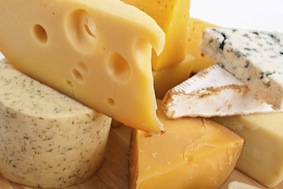Around the turn of the 19th century, when there was something of a fad for home microscopes and the discoveries of the microscopic world, the sudden knowledge that cheese was inhabited by thousands of microscopic crab-like bugs known as cheese mites, resulted in a distinct downturn in cheese sales.
Click below for the flying cheese.
Hey, that was only one fact about cheese, and I probably knew that already from Stephen Fry!
Yes, that’s a valid protest. I apologize. It was one of those trick titles you see all over the internet. There are countless articles touting “Seven Of This….” or “Three Of That…” and you think, seven things, reading that won’t take too much of my time, and it should be mildly interesting, because who doesn’t want to know seven new facts about cheese, Emma Watson, or such and such?
However, when you get there, the facts are seldom anything new. At least I had the common decency, once I had drawn you in with a false title, not to bore you with the disappointing list of seven facts of which you were already well aware.
On a related issue, Stephen Fry has stated in the very same fascinating trivia program that the white powder seen on old cheese is the excreta of thousands of cheese mites. This is a fallacy. It is in fact simple calcium lactate, a deposit left behind as moisture leaves the cheese. Or, on pre-packaged grated parmesan or string cheese, it is powdered cellulose (essentially the same as wood pulp), used to prevent clumping or the cheese sticking together.
While we are discussing Fry and cheese, Saganaki, a popular Greek appetizer consisting of fried cheese, gets its name not from the cheese itself, but from the pan it is cooked in. Saganaki is a diminutive of sagani, a frying pan with two handles, which comes from the Turkish word sahan ‘copper dish’, itself borrowed from the Arabic صحن ṣaḥn.
How is Saganaki a diminutive of Sagani, when Saganaki is the longer word? Well, that’s one of those contradictions of language, where the diminution is a matter of informality and cuteness, rather than size. It is a diminution in concept, as with nick or pet names which are made longer than original by adding -ette in French, or –ushka in Russian. Thus Zdravushka, a popular producer of cheese and other dairy products is a diminutive derived from Zdrav, Zdravo (in the Slavonic languages) or Zda-ró-vye, the well known drinking salutation meaning ‘health’ in Russian, while Cheesette is both a nick name, an actual name, a small cheese, and a cube of bread dipped in egg and butter, coated in cheese and baked in the oven. However, an exploration of the complexities of diminutives would require a whole another “Seven Things You Didn’t Know About…” article, and I certainly do not want to delay or deceive you any further.


